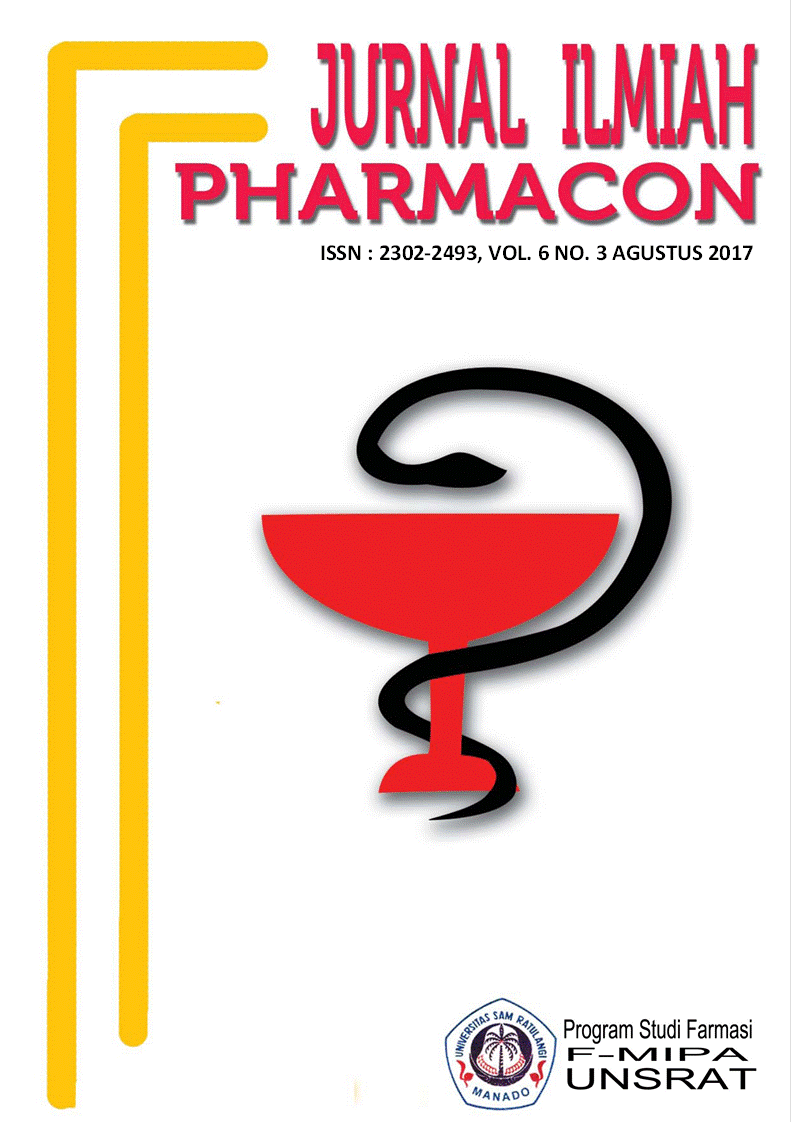PENETAPAN KADAR BORAKS PADA KERUPUK OLAHAN DI DISTRIK HERAM KOTA JAYAPURA MENGGUNAKAN SPEKTROFOTOMETER UV-VIS
DOI:
https://doi.org/10.35799/pha.6.2017.16940Abstract
PENETAPAN KADAR BORAKS PADA KERUPUK OLAHAN
DI DISTRIK HERAM KOTA JAYAPURA MENGGUNAKAN SPEKTROFOTOMETER UV-VIS
Â
Fitry Anreny1), Eva Susanty Simaremare1), Rusnaeni1)
1)Program Studi Farmasi, Fakultas MIPA Universitas Cenderawasih, Jayapura, Kampus UNCEN Waena, Jl. Perumnas III Waena- Jayapura 99358
Email*: eva_smare@yahoo.com
ABSTRACTÂ
              Borax is a compound with the chemical name sodium tetraborate or borax salt (Na2B4O7.10H2O) and boric acid (H3BO3). Other names are borax crystals, pijer, or gendar that are commonly misused by manufacturers to make crackers more crisp and attractive. The purpose of this study is to identify and perform the assay borax using qualitative methods to test the flame, and turmeric paper; as well as the quantitative test using Spectrophotometer UV-Vis. Samples were taken from 5 crackers that are processed Heram District Jayapura City. The results were obtained maximum wavelength of 545 nm. Prior to use of the samples taken from the District Heram this method is validated. Results from the study showed a linear calibration curve on rentamg 0,1 to 1,2 µg/ml with a regression equation y = 0,5143x + 0,1233 and the correlation coefficient (r) = 0,9988. LOD acquisition value was 0,142 mg/ml and the LOQ 0,474 mg/ml; accuracy or recovery value is 96,924%; precision or results of standard deviation and standard deviation relatife or coefficient of variation (CV) is 1,026% and 1,066%. The validation of the test showed that all valid methods that have been done, so it can be carried out on a sample of the assay borax. From the results of this study as many as 5 crackers samples were tested, three samples tested positive reveal any qualitative and quantitative testing borax obtainedthe lowest levels of 6,556 µg/g, 424,033 µg/g and the highest level of 908,556 µg/gram.ÂKeywords: Borax, Crackers, Curcumin, Spectrophotometer UV-Vis.
ABSTRAKÂ
Boraks adalah senyawa dengan nama kimia natrium tetraborat atau garam boraks (Na2B4O7.10H2O) dan asam borat (H3BO3). Nama lainnya adalah bleng kristal, pijer, atau gendar sering disalahgunakan oleh produsen untuk membuat kerupuk lebih renyah dan tampak menarik. Tujuan penelitian ini adalah untuk mengidentifikasi dan melakukan penetapan kadar boraks menggunakan metode kualitatif dengan uji nyala api, dan kertas kunyit; serta uji kuantitatif dengan menggunakan Spektrofotometer Uv-Vis. Sampel diambil dari 5 kerupuk olahan yang berada di Distrik Heram Kota Jayapura. Hasil penelitian diperoleh panjang gelombang maksimum 545 nm. Sebelum digunakan terhadap sampel yang diambil dari Distrik Heram metode ini divalidasi. Hasil dari penelitian menunjukkan kurva kalibrasi linear pada rentamg 0,1-1,2 µg/ml dengan persamaan regresi y = 0,5143x + 0,1233 dan koefisien korelasi (r) = 0,9988. Perolehan nilai LOD adalah 0,142 μg/ml dan LOQ 0,474 μg/ml; nilai akurasi atau perolehan kembali yaitu 96,924%; presisi atau hasil simpangan baku dan simpangan baku relatife atau koefisien variasi (KV) adalah 1,026% dan 1,066%. Dari uji validasi tersebut menunjukkan bahwa semua metode yang telah dilakukan valid, sehingga dapat dilakukan penetapan kadar boraks pada sampel. Dari hasil penelitian ini sebanyak 5 sampel kerupuk yang diperiksa, 3 sampel yang diuji secara kualitatif positif ditemukan adanya boraks dan dengan pengujian kuantitatif diperoleh kadar terendah 6,556 μg/gram, 424,033 μg/gram dan kadar tertinggi 908,556 μg/gram.
Â
Kata kunci: Boraks, Kerupuk, Kurkumin, Spektrofotometer UV-Vis
Downloads
Published
How to Cite
Issue
Section
License
Authors who publish with this journal agree to the following terms:
- Authors retain copyright and grant the journal right of first publication with the work simultaneously licensed under a Creative Commons Attribution-NonCommercial 4.0 International License that allows others to share the work with an acknowledgement of the work's authorship and initial publication in this journal.
- Authors are permitted and encouraged to post their work online (e.g., in institutional repositories or on their website) prior to and during the submission process, as it can lead to productive exchanges, as well as earlier and greater citation of published work (See The Effect of Open Access)










